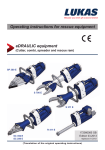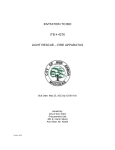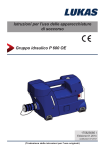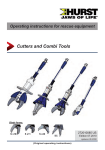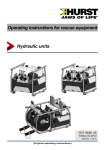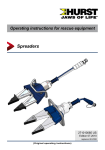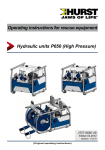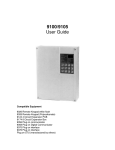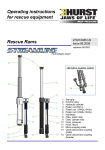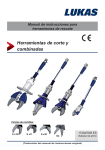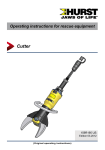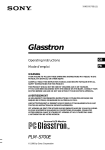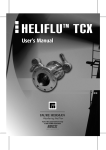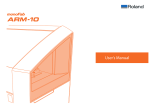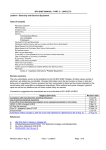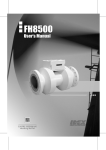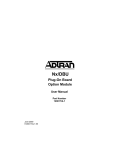Download SC 250E Tactical Combi User Manual
Transcript
Operating instructions for rescue equipment eDRAULIC equipment (Cutter, spreader and rescue ram) SP 300 E S 700 E S 311 E R 411 E SC 350 E 272080085 US Edition 03.2011 replaces 02.2011 (Original operating instructions) Content Page 1. Hazard classes 4 2. Product safety 5 3. Proper use 8 4. Description of the functions 10 4.1Description 10 4.2 Structure of the rescue equipment 11 4.3 Circuit diagram 14 4.4 Controlling the operating movements 14 5.Operation 15 5.1 Battery or power supply for eDRAULIC device 15 5.2 Operating the star grip 15 6. Cutting, spreading, pulling, squeezing and pushing 16 6.1 Safety instructions 16 6.2Cutting (cutter and combi tool) 17 6.3Spreading (spreader and combi tool) 18 6.4Pulling (spreader, combi tool) 19 6.5Squeezing (spreader, combi tool) 20 6.6Pushing (rescue ram) 21 7. Dismantling the equipment / deactivation following operation 8. Maintenance and service 22 22 8.1 Overview of eDRAULIC devices 23 8.2 Protective devices 24 9.Repairs 24 9.1 General information 24 9.2 Preventative maintenance 24 9.3Repairs 25 10.Troubleshooting 36 2 11. Technical data 38 11.1 eDRAULIC cutter 38 11.2 eDRAULIC combi tool 39 11.3 eDRAULIC spreader 40 11.4 eDRAULIC rescue ram 41 11.5 Noise emission (in accordance with the EN ISO 3744 standards) 41 11.6 Operating and storage temperature ranges 42 11.7 Oscillation / vibration 42 12.Accessories 43 13. Instructions regarding disposal 45 13.1 Batteries 43 13.2 Battery charger 43 13.3 Power supply 44 13.4 Extension for rescue rams 45 13.5 Chain sets 45 14.Notes 46 3 1. Hazard classes We distinguish between various categories of safety instructions. The table below gives you an overview of the assignment of symbols (pictograms) and key words to the specific hazard and possible consequences. Damage / injury to Key word device human Pictogram - Definition Consequences DANGER! Immediate danger Death or major injury WARNING! Potentially dangerous situation Potential death or major injury CAUTION! Less dangerous situation Minor or slight injury CAUTION! Danger of damage to device / environment Damage to the equipment, damage to the environment, damage to surrounding materials NOTE Advice for application and other important / useful information and advice No injury / damage to persons / environment / equipment Wear helmet with face protection Wear safety gloves Wear safety shoes Proper recycling Observe principles of environmental protection Read and observe operating instructions 4 2. Product safety HURST products are developed and manufactured in order to guarantee the best performance and quality when used properly. Operator safety is the most important aspect of the product design. Moreover, the operating instructions are intended to help the safe use of HURST products. The generally applicable, legal and other binding regulations pertaining to the prevention of accidents and protection of the environment apply and are to be implemented in addition to the operating instructions. The equipment may only be operated by persons with appropriate training in the safety aspects of such equipment – otherwise, there is a danger of injury. We would like to point out to all users that they should carefully read and adhere to the operating instructions before they use the equipment. We further recommend that a qualified trainer train you in the use of the product. WARNING / CAUTION! The operating instructions for accessories must also be taken into account! Even if you have already received instructions on how to use the equipment, you should still read the following safety notes again. WARNING / CAUTION! Please ensure that the accessories you use are appropriate for the maximum operating pressure and the performance of the rescue device! Please ensure that no body parts or clothing are caught between the visibly moving parts (e.g. blade arms). Working under suspended loads is not permitted where such loads are being lifted only by means of hydraulic or electro-hydraulic devices. If this work is absolutely imperative, additional mechanical supports must be used. Wear protective clothing, safety helmet with visor, protective gloves Inspect the equipment before and after use for visible defects or damage The responsible department is to be informed immediately of any changes (including to the operating behaviour)! If necessary, the equipment is to be deactivated immediately and secured! All bolted connections must be checked for leaks and externally visible damage, which must be repaired immediately! Squirting hydraulic fluid can result in injuries and fires. 5 In the event of malfunctions, immediately deactivate the equipment and secure it. The malfunction is to be repaired immediately. Do not carry out any changes (additions or conversions) to the equipment without obtaining the prior approval of HURST. Observe all safety and danger notes on the equipment and in the operating instructions. All safety and danger notes on the equipment are to be kept complete in a legible condition. Any mode of operation which impairs safety and/or stability of the equipment is forbidden! Repairs to the equipment may only be carried out by a trained service technician with specific knowledge of the device. Safety devices must never be deactivated! Only original HURST accessories and spare parts may be used for repairs. Before the equipment is switched on/started up, and during its operation, it must be ensured that nobody is endangered by the operation of the equipment. Comply with all specified dates or dates specified in the operating instructions pertaining to regular controls / inspections on the equipment. When working in the proximity of live components and wires, appropriate steps must be taken to avoid current flow or high-voltage discharge through the device. Please note that material could fall down or suddenly break free during spreading, cutting, squeezing and pushing operations as a result of shearing, tearing or breaking; appropriate countermeasures must be taken. Please ensure that you do not become entangled in cables and trip when working with or transporting the device. Please ensure that the battery contacts are not short-circuited. The build-up of static charge with the potential consequence of spark formation is to be avoided when handling the equipment. Only touch any broken-off parts or the cut-off parts wearing protective gloves, since the torn / cut edges can be very sharp. 6 Protect the eDRAULIC devices against humidity and moisture The eDRAULIC devices are not suitable for underwater use. The equipment is filled with hydraulic fluid. These hydraulic fluids can be dangerous to health if swallowed or their vapours inhaled. Direct contact with the skin is to be avoided for the same reason. Please also note that hydraulic liquids can also have a negative effect on biological systems. When working with or storing the equipment, ensure that the function and the safety of the equipment are not impaired by the effects of extreme external temperatures or that the equipment is damaged in any way. Please note that the equipment can also heat up over a long period of use. Ensure adequate lighting when you are working. Before transporting the equipment, always ensure that the accessories are positioned such that they cannot cause an accident. Always keep these operating instructions within reach where the equipment is used. Ensure the proper disposal of all removed parts, left-over oil and hydraulic fluid as well as packaging materials! The generally applicable, legal and other binding national and international regulations pertaining to the prevention of accidents and protection of the environment apply and are to be implemented in addition to the operating instructions. WA R N IN G / C A U T I O N! The equipment is to be used exclusively for the purpose stated in the operating instructions (see chapter “Proper Use”). Any other or further use is not considered proper use. The manufacturer / supplier is not liable for any damages resulting from improper use. The user bears sole responsibility for such. Observance of the operating instructions and compliance with the inspection and maintenance conditions are part of the proper use. Never work when you are overtired or intoxicated! 7 3. Proper use HURST eDRAULIC devices have been specially designed to rescue or retrieve the bodies of victims of road, rail or aircraft accidents or to be used during rescue operations from buildings. HURST eDRAULIC cutters and combi tools are used to free injured persons at accident scenes by cutting through doors, roof beams and hinges. The HURST eDRAULIC spreader and combi tool can also be used to free persons who have become trapped by pushing open doors or removing obstacles with the aid of a chain set. HURST eDRAULIC rescue rams are used to free persons who have become trapped during a car accident when the spreader does not open wide enough, for example by spreading or lifting parts of vehicles. During other catastrophic events, rescue rams and spreaders can also be used to move objects to rescue persons who have been buried or trapped. Care must be taken that the object to be processed has been secured with firm supports or substructures. HURST eDRAULIC devices are NOT suitable for underwater use. WARNING / CAUTION! Care must be taken that the object to be processed has been secured with firm supports or substructures. WARNING / CAUTION! The following may not be cut / squeezed: - live cables - hardened parts such as springs, spring steels, steering columns and rollers - tubes / hoses under gas or liquid pressure, - compound materials (steel/concrete) - explosive bodies such as airbag cartridges The operating pressure set of the rescue device may only be changed after consultation of HURST directly. A change in settings may result in damage to property and/or injuries. eDRAULIC devices may NOT be used where there is a risk of explosions! The rescue equipment should not come into contact with acids or alkalis. If this is unavoidable, clean the equipment immediately afterwards with a suitable cleaning agent. Spare parts and accessories for the rescue tools can be ordered from your authorised HURST dealer! 8 Applications: 9 4. Description of the functions 4.1Description The cutters and combi tools have been designed in such a way that a hydraulically operated piston activates mechanical joints symmetrically to open or close a set of two opposite blade arms, thus enabling objects to be cut. The spreaders operate according to a similar principle. They, too, have been designed in such a way that a hydraulically operated piston activates mechanical joints symmetrically to open or close a set of two opposite spreader arms. This movement can then be used to spread open, squeeze or pull open objects. The rescue rams are double-acting hydraulic cylinders. Extension and retraction takes place hydraulically. On all devices, the movement is activated by means of a valve in the form of a star grip. All devices guarantee the dead man's switch and the full load-supporting function when the star grip is released. HURST eDRAULIC devices do not need to be connected to an external hydraulic source (e.g. a motor pump). Generation of the required hydraulic pressure takes place within the body of the device. Either a battery or an external power supply must be connected as an energy source. You can choose which energy source you wish to use. Both the battery and the power supply can be plugged into the opening provided in the body of the tool. Both will lock in place automatically. When using batteries as an energy source, you have almost unlimited freedom of movement when working, i.e. there are no cables or hoses to hinder you. You can extend the operating time of your eDRAULIC device by using several batteries. The batteries can be recharged after use, using a suitable external charger When using an external power supply, you have an almost unlimited operating time, which will only be limited by the external energy source. To allow you to select the best possible energy supply for your eDRAULIC device, neither the battery nor the power supply form part of the delivery scope. You will find suitable batteries and power supplies in the HURST accessories list. This will allow you to choose from a range of batteries and power supplies. The eDRAULIC devices have all been equipped with lights to facilitate work under poor lighting conditions. The light-emitting diodes attached on the operating side light up the work area. The main switch has also been provided with a light, so that you can see at a glance whether the device is switched on. When exchanging the battery or power supply, the connection slot will be lit up for approximately 30 seconds. 10 4.2 Structure of the rescue equipment 4.2.1Cutter 1 3 2 10 4 12 11 6 8 9 5 7 11 1 1 Star grip 2 Main switch 3 Quick exchange battery or power supply 4 Unlocking button for battery and power supply 5Handle 6 Ventilation slits 7 Blade arms 8 Pivot bolt with secured nut 9 Plastic casing 10 Device body 11 Protective cover 12 Illumination 2 3 12 5 4 11 8 6 7 10 11 9 4.2.2 Combi tool 1 3 2 12 4 5 6 10 1 Star grip 2 Main switch 3 Quick exchange battery or power supply 4 Unlocking button for battery and power supply 5Handle 6 Ventilation slits 7 Blade arms 8 Pivot bolt with secured nut 9 Plastic casing 10 Device body 11 Protective cover 12 Illumination 8 7 9 11 4.2.3Spreader 1 3 2 11 5 4 6 9 8 10 7 12 1 Star grip 2 Main switch 3 Quick exchange battery or power supply 4 Unlocking button for battery and power supply 5Handle 6 Ventilation slits 7 Spreader arms with plugon tips 8 Plastic casing 9 Device body 10 Protective cover 11 Illumination 4.2.4 Rescue ram 11 3 1 10 2 8 11 9 5 7 6 13 1 Star grip 2 Main switch 3 Quick exchange battery or power supply 4 4 Unlocking button for battery and power supply 5 Ventilation slits 6 Cylinder piston 7 Plastic casing 8 Device body 9 Top claw 10 Bottom claw 11 Illumination NOTE: When working with the eDRAULIC rescue ram, it should be applied to the object to be processed in such a way that the battery or power supply can be replaced at any time. 4.3 Circuit diagram To enable comprehension of the function, a simplified hydraulic cylinder of the rescue equipment (A) + hand valve (B) are depicted here. cut / close / pulling / squeezing or extend piston A spreading / opening B or retract piston 4.4 Controlling the operating movements The piston movement is controlled by the star grip on the attached valve (see illustration below). Star grip 14 5. Operation 5.1 Battery or power supply for eDRAULIC device 5.1.1 Initial operation Before initial operation, the battery (where used) of the rescue device must be fully loaded, using the external charger. Procedure: 1. Unplug the power supply (where used) from the mains. 2. Fully press down the two unlocking buttons and carefully pull the battery or power supply out of the device. Do not use force! Connection slot 3. The battery can now be recharged in the charger (please take note of the separate operating instructions for the charger and the batteries to be used); alternatively, the power supply can be replaced. 4. Insert the recharged or new battery into the eDRAULIC device until it reaches the stop. The battery or power supply will be automatically locked when correctly operated. 5.2 Operating the star grip (also see chapter on "Controlling the operating movements") Open the device or extend the piston ( / ): Turn the star grip in the direction of the corresponding symbol (open / extend)and hold it in this position. Close the device or retract the piston ( / ): Turn the star grip in the direction of the corresponding symbol (close / retract)and hold it in this position. “Dead-man’s” function: Following release, the star grip automatically returns to the central position, fully guaranteeing load-retention. 15 6. Cutting, spreading, pulling, squeezing and pushing 6.1 Safety instructions Before rescue work can commence, the position of the obstacle must be stabilised. You must ensure an adequate substructure and / or adequate support for the object. World-wide, safety guidelines pertaining to the specific country are to be observed and complied with. Regular safety tests according to the regulations of the GUV (Gesetzliche Unfallversicherung - legally prescribed accident insurance) must be carried out in Germany. WARNING / CAUTION! HURST rescue tools are not explosion protected! When using the tools in areas at risk of explosion, you must ensure that no explosion will be caused by the tool or any by work using it, e.g., by cutting an object (can cause sparks). The responsibility for this rests with the operator of the tool. When working in areas at risk of explosion, all applicable legal, national and international regulations, standards and safety rules for preventing explosions must be observed without limitation! The following are to be worn when working with the rescue equipment: - protective clothing, - safety helmet with visor or protective goggles, - protective gloves - and, if necessary, ear protection Before operating the rescue device, you should ensure that no participants or bystanders are at risk from the movements of the rescue device or from flying fragments! Further avoid unnecessary damage to property belonging to others, objects not involved by the rescue equipment / flying fragments. It is strictly prohibited to reach into the path of the rescue device (e.g. between the blades or spreader arms or between the rescue ram and the material to be processed)! WARNING / CAUTION! The particular effect of the force of the rescue equipment during operation could cause pieces of the vehicle to break off or fly off, posing a danger to persons. Those not involved in the rescue operation should therefore keep at a distance appropriate to the situation. Any trapped or enclosed persons must be protected. 16 6.2Cutting (cutter and combi tool) The blades should be positioned at a 90° angle to the object to be cut, if possible. 15° 15° 12 90° 9 3 WRONG RIGHT Higher cutting capacities can be achieved by cutting as close as possible to the blade’s pivot point. WRONG RIGHT During cutting, the gap between the blade tips (in the transverse direction) must not be exceeded, otherwise the blade is in danger of breaking: eDraulic tool S 311 E S 700 E SC 350 E max. gap on the blade tips [mm] / [in.] 3 / 0.12 3 / 0.12 3 / 0.12 CAUTION! Avoid cutting through the hardest parts of the vehicle body (e.g. lateral collision protection), as this may result in damage to the cutters or to more wear and tear! 17 6.3Spreading (spreader and combi tool) Use the front area of the tips for increasing the gap only. To increase grip and to avoid having the tips slip or break out of the part to be processed, the grip should be reapplied at an early stage. In any case, the highest force is developed in the rear area of the plug-on tip or in the rear spreading area of the combi blades. WARNING / CAUTION! The light metal alloy spreader arms must not be damaged. Spreading Working surface is too small, tips slip off. Only for increasing the size of a gap (not suitable for spreading) Tips get a safe grip. 18 Enlarging a gap Work with the tips only. Do not damage the spreader arms! 6.4Pulling (spreader, combi tool) WARNING / CAUTION! The light metal alloy arms must not be damaged. - HURST chain sets must be used for pulling. - When using the traction chain, the pins and hooks must be in the correct position to ensure that the chain cannot slip. - Only chain sets in perfect condition may be used. - The traction chains must be checked by an expert at least once a year. - Also consult the separate operating instructions for the corresponding chain set! Attachment hole for chain sets The connecting pieces for HURST chain sets are fastened to the blades using load bolts in holes "A". (see illustration on the right) A Chain sets: for SC350E: KSV 8/50 for SP300E: KSV 11 NOTE: Take note also of all the instructions and regulations in the separately supplied operating instructions for the chain sets. 19 6.5Squeezing (spreader, combi tool) WARNING / CAUTION! The light metal alloy arms must not be damaged. Squeezing area Squeezing may only take place near the tips (see figure below). Squeezing area 20 6.6Pushing (rescue ram) Before using the rescue ram, you must ensure that it is adequately supported and has the required substructure. The rescue rams have been equipped with a claw on the cylinder and piston sides to ensure their safest possible use. Where this support is not adequate, e.g. when pushing away the front part of the vehicle or when pushing a vehicle upwards, additional supports, cylinder attachments and the use of holding straps may be required. You will find suitable support bearings and cylinder attachments in the HURST accessories list. WARNING / CAUTION! Never use a rescue ram without a claw or the required accessories! The cylinder could slip during the operation, resulting in injury to the user. In addition, the piston rod or the claw support could be damaged. WARNING / CAUTION! When applying the rescue ram (without the HURST support), care must be taken to ensure that all four tips of both claws, i.e. on the piston and the cylinder side, are in good contact with the object. When applying the rescue ram (to a HURST support), care must be taken to ensure that the surface between the four tips of the claw is in contact with the round bearing rods. This will prevent the unilateral application of force to the cylinder. Objects lifted up must be subsequently secured with firm supports or substructures! An extension is also available for the eDRAULIC rescue ram. B Procedure for installing the extension: A 1.First pull the claw "A" off the cylinder base. Check whether the O-ring "B" is still attached to the cylinder base and is in good condition. Where necessary, replace the O-ring. 2. Check the good fit of the O-ring "B", grease the contact surfaces using HURST special grease and insert the extension "C" onto the cylinder base until it reaches the stop. B C 3. When the extension is no longer required after the operation, remove it by following the instructions in the reverse order and store it in a suitable place. 21 7. Dismantling the equipment / deactivation following operation Once work has been completed, the arms should be closed until the tips are only a few millimetres apart or the cylinder piston should be almost fully retracted. This relieves the hydraulic and mechanical strain on the equipment. NOTE: Never store the eDRAULIC devices with fully closed arms or a fully retracted piston! By fully closing the arms or retracting the cylinder piston, hydraulic and mechanical tension may develop in the device. Clean the rescue device after each operation and grease both the metallic and the mechanically movable parts. The lock of the spreader plug-on tips should also be greased from time to time. Greasing provides protection against excessive wear and tear or corrosion. Avoid storing the rescue equipment in a damp environment. 8. Maintenance and service The equipment is subject to very high mechanical stresses. A visual inspection is to be carried out after every use: however, at least one visual inspection is to be carried out every six months. These inspections enable the early detection of wear and tear, which means that punctual replacement of this wearing parts prevents breakages from occurring. Regularly check the torque of the pivot bolt on the cutting and combi tools. (you will find the torques for the pivot bolt in the chapter on "Technical Data") An annual inspection of the tool is due once per year. This inspection may only be carried out by specially trained personnel. These personnel must possess an appropriate, valid HURST certificate. Every three years a crack test of the blades is also essential. Therefore a special crack testing kit is available. Every three years or if there is any doubt regarding the safety or reliability of the equipment, a function test must also be performed. (Please also observe the relevant valid national and international regulations pertaining to service intervals of rescue equipment). Regular safety tests according to the regulations of the GUV (Gesetzliche Unfallversicherung - legally prescribed accident insurance) must be carried out in Germany. CAUTION! Clean off any dirt before checking the equipment! WARNING / CAUTION! In order to carry out maintenance and repair work, tools appropriate for the job and personal protecting equipment are essential. The maintenance and repair staff must have adequate technical and specialised knowledge. HURST offers appropriate training courses for this. 22 8.1 Overview of eDRAULIC devices Inspections to be carried out: Visual inspection Cutter and combi tool • Opening width of the blade arms on the tips (see chapter “Technical data”), • General tightness (leaks), • Operability of the star grip, • Existence and stability of handle, • Labels completely existent and legibly, • Covers in perfect condition, • Check the torque of the pivot bolt (for torque MA, see “Technical Data”). • Blade arms free of cracks and without any chipped spots or deformations on the cutting surfaces, • Cutting surfaces go on top of each other without making contact, • The sliding plates, bolts and retaining rings of the blade arms are in place and in good condition, • Illumination of main switch, work area and connection slot fully functional. Spreader • Opening width of arms at the tips (see chapter on "Technical Data"), • General tightness (leaks), • Operability of the star grip, • Existence and stability of handle, • Labels completely existent and legibly, • Covers in perfect condition, • Spreader arms not cracked, • Bolts and retaining rings of spreader arms in place and in good condition, • The corrugations on the tips should be clean and square, without cracks • The tips must be in place and locked • Illumination of main switch, work area and connection slot fully functional. Rescue ram • Piston can be extended to its full length (see chapter on "Technical Data"), • Cylinder and piston rod undamaged and not deformed, • Correct and firm fit of claws, • Claws can be turned and are undamaged (no break-outs), • General tightness (leaks), • Operability of the star grip, • Labels completely existent and legibly, • Illumination of main switch, work area and connection slot fully functional. Battery and power supply • Casing undamaged, • Electrical contact surfaces clean and undamaged • Cable undamaged • Battery(-ies) fully charged (when used) • Charging state display of lithium/ion battery(-ies) fully functional Function test • Easy opening and closing or extension/retraction of star grip controls, • no suspicious noises. • no further movement of cutter and spreader arms or cylinder piston when interrupting the valve function during the process (dead man's switch), 23 8.2 Protective devices • Check of the protective equipment on / around the rescue equipment, especially the hand guard for the moveable parts (this must be free of cracks!). 9.1 General information 9. Repairs Servicing may only be carried out by the manufacturer or personnel trained by the manufacturer and by authorised HURST dealers. Only HURST spare parts may be used to replace all components (see spare parts list) since special tools, assembly advice, safety aspects, inspections might have to complied with (see also chapter “Maintenance and Service”). During assembly, ensure the complete cleanliness of all components, since dirt can damage the rescue equipment! WARNING / CAUTION! Protective clothes must be worn when repairs are being carried out, since parts of the units can also be pressurised in an idle state. NOTE: You must always return the warranty registration card to HALE PRODUCTS, INC. or register your equipment on the HURST website. Only then are you entitled to the extended guarantee. CAUTION! Because HURST rescue equipments are appropriate for highest achievements, only components may be exchanged, which are specified in the spare parts list of the appropriate equipment. Further components on the equipment may only be exchanged, if: - you have participated in an appropriate HURST service training. - you have the express permission of HURST Customer Service (valid HURST certificate necessary!) CAUTION! When cleaning the equipment, take care not to use any cleaning agent that has a pH value outside the range 5 - 8! 9.2 Preventative maintenance 9.2.1Maintenance instructions From time to time, the outside of the device should be cleaned with a damp cloth (not the electrical contacts in the connection slot, the battery or on the power supply) and oil should be applied to the metallic surfaces (not the electrical contacts in the connection slot, on the battery or on the power supply) to prevent corrosion. (In case of doubt, contact your authorised HURST dealer or HURST directly!) 9.2.2Function and load test If there is any doubt regarding the safety or reliability of the equipment, a function and load test must also be performed. HURST offers appropriate test equipment to this end. 24 9.3Repairs 9.3.1Blades, protective cover and handle replacement for the S700E cutter Components to be replaced Required work steps Protective cover 1., 2. and 7. Pivot bolt 1. - 4. and 7. Handle 1. - 5. and 7. Blade 1. - 6. and 7. Work steps: 1. First of all, carefully clean the rescue equipment. 2. Remove the fixing screws “A” and remove the protective cover “B” and the cover caps “C”. B C D A B C 25 3. Move the blade arms on the unit until the pin “E“ and the locking rings “F” can be accessed through the hole "D". Now switch off the device and remove the battery or unplug the power supply from the device. F E H G 4. First remove the grub screw “G”, then the pivot bolt nut “H” and then pull out the pivot bolt “J”. L J 5. Release the fixing screws “K” and remove them. The handle “L” can now be pulled out forwards over the blades. N O K M 6. Remove the locking rings “M” and push the pin “N” out. You can then pull out the blades “O” and the slide plates "P" P M N O 26 7. The work steps must be carried out in reverse order to fit the new parts. CAUTION! Don’t forget to apply HURST special grease to all sliding surfaces. NOTE: The torque required can be taken from the spare parts list of your particular device. 9.3.2Changing the blades, protective cover and handle on the S311E cutter and the SC350E combi tool NOTE: The illustrations show the equipment with the blade arms of the cutter tool. Assembly and disassembly are identical for the combi tool! Components to be replaced Required work steps Protective cover 1. - 9. and 10. Pivot bolt 1., 5. and 10. Handle 1. - 3. and 10. Blade 1. - 7. and 10. Work steps: 1. First of all, carefully clean the rescue equipment. 2. As a next step, you should close the blade arms until the tips almost touch each other. NOTE: The blade bolts are only accessible when the blade arms are almost touching Further procedure: 3. Remove screws “A” from handle “B”. The handle can then be removed. B A 27 E F 4. Push the hand guard "E" in the depicted direction until the securing bolts "F" are easily accessible. F D 5. Remove self-locking nut "D" and push the pivot bolt "G" out. H J G 6. Remove the retaining rings "H" and push out bolt "J". L J H 7. Now, you can remove blade "K" and sliding plates "L". M K 8. Fold in the lever elements "M". M 28 9. Finally, remove the hand guard "E" from the equipment as depicted. E 10. The work steps must be carried out in reverse order to fit the new parts. CAUTION! Don’t forget to apply HURST special grease to all sliding surfaces. CAUTION! The nut of the pivot bolt and the pivot bolt itself are matched by a special procedure. Therefore they must only be changed as a set by using a new set! Because of the special procedure an unscrewing of the nut while working will be minimised and a resulting blade crack will be prevented. The nuts can be unscrewed and tightened up to 10 times without affecting the service performance! NOTE: The torque required can be taken from the spare parts list of your particular device. 29 9.3.3 Sharpening the blades Only remove and smoothen any burrs! Chips or deep grooves cannot be ground away. The blades must be replaced in these cases. CAUTION! Only grind in the grinding area (see illustration)! The sliding faces, in particular, must not be reground! Grinding area Pivot point Blade arm Direction of movement Blade arm Slide surface plane Tools required: 1. Use jaw protection on clamping device (e.g. vice) in order not to damage the blades 2. Grinder (e.g. angle grinder or belt grinder) with abrasive having a grain size of 80. Procedure: 1.Clamp the blade securely into the clamping device so that it cannot move, but with the grinding area exposed. 2.Carefully grind the burr away evenly until you reach the sliding surface level. (see illustration) Slide surface plane In addition, when grinding, you must make sure that the inclination of the cutting surface in the direction of the blade arm movement is not changed. Check the incline and smoothness of the ground surface, using a suitable measuring tool. CAUTION! If you have not maintained the smoothness or incline, the proper operation of the blade is no longer guaranteed and the blades must be replaced. 30 9.3.4 Spreader arm, spreader tips, protective cover and handle exchange for the spreader Components to be replaced Required work steps Handle 1., 2. and 8. Plug-on tips 1., 5. and 8. Protective cover 1. - 4. and 8. Lever links 1. - 4., 6. and 8. Spreader arms 1. - 6. and 8. Work steps: 1. First of all, carefully clean the rescue equipment. Now switch off the device and remove the battery or unplug the power supply from the device. A 2. Remove the fixing screws “A” and remove the handle “B”. B 31 C C 3. Remove the screws “C“ and “D”. D C E C 4. Remove the two two-piece locking elements "E" on the protective cover "F" and remove the two-piece protective cover by pulling it sideways. F F 32 5. To remove the plug-on tips "G", you must simultaneously press together the buttons "J" on both sides of a spreader arm "H" and then pull the plug-on tip forwards from the spreader arm. H J H J G G 6. You need to remove the retaining rings “K” and the lever links “L” to replace the spreader arms "H". K L K L H L K L K K 33 7. Also remove the retaining rings "M" and remove the pins "N". You can then remove the spreader arms “H”. H M N H M 8. The work steps must be carried out in reverse order to fit the new parts. CAUTION! Don’t forget to apply HURST special grease to all sliding surfaces. NOTE: The torque required can be taken from the spare parts list of your particular device. 34 9.3.5 Rescue ram Work steps for exchanging the cylinder piston claw: 1. First of all, carefully clean the rescue equipment. Now switch off the device and remove the battery or unplug the power supply from the device. A B 2. Pull the claw "A" off the cylinder piston and remove the O-ring "B". If the O-ring is damaged, it must be replaced. 3. Insert the O-ring "B" into the groove of the new claw "A" provided and check it for a firm fit. Grease the contact surfaces with HURST special grease and then slide the new claw onto the cylinder piston up to the stop. Work steps for exchanging the cylinder base claw: 1. First of all, carefully clean the rescue equipment. Now switch off the device and remove the battery or unplug the power supply from the device. D C 2. Pull the claw "C" off the cylinder base and check whether the O-ring "D" in the cylinder base has been damaged; if yes, replace it. 3. Check the firm fit of the O-ring "D", grease the contact surfaces with HURST special grease and then slide the new claw "C" onto the cylinder base up to the stop. 9.3.6Labels All damaged and/or illegible labels (safety notices, type plate, etc.) must be renewed. Procedure: 1. Remove damaged and/or illegible labels. 2. Clean surfaces with industrial alcohol. 3. Attach new labels. Ensure that you attach the labels in the correct position. If you are no longer sure about this, then please contact your authorised HURST dealer or HURST itself. 35 10. Troubleshooting Trouble Blades, spreader arms or cylinder pistons move slowly or jerkily when operated Blades, spreader arms or cylinder pistons do not move when operated. Device doesn’t perform at its given power Control Battery fully charged? Cause Battery flat Solution Charge battery Battery defective Replace battery Air in the hydraulic system Repair of fault by authorised dealer, staff specially trained by HURST or directly by HURST Reinsert power supply into the connection slot. Power supply cable Power supply connected? not properly connected to the eDRAULIC device (not automatically locked). Power supply cable not properly connected to the external power supply. Power supply or power supply cable defective. External power source defective. Battery fully Battery flat charged? Battery defective Reconnect external power supply. Replace power supply or power supply cable. Use other external power source Charge battery Replace battery Power supply cable Power supply cable Replace power supply connected? defective cable Device defective Repair of fault by authorised dealer, staff specially trained by HURST or directly by HURST Device defective Repair of fault by authorised dealer, staff specially trained by HURST or directly by HURST 36 Trouble Following release, the star grip doesn’t return to the central position Control Casing damaged or star grip operation does not work smoothly? Hydraulic fluid leaks on the piston rod The useful operating time between the individual charging cycles is less than 5 minutes, despite charging the batteries according to the instructions. Cause Damage to the torsion spring for reset Soiled valve or star grip Defective valve Other mechanical damage (e. g. star grip) Defective rod seal Damage to the piston Battery defective Solution Repair of fault by authorised dealer, staff specially trained by HURST or directly by HURST Repair of fault by authorised dealer, staff specially trained by HURST or directly by HURST Replace battery If it isn’t possible to rectify the malfunctions, inform an authorised HURST dealer or the HURST customer service department immediately! The address for the HURST customer service department is: HURST JAWS OF LIFE HALE PRODUCTS, INC. A Unit of IDEX Corporation 711 N. Post Road Shelby, NC 28150 USA Phone: (704) 487-6961 Fax: (704) 487-7271 e-mail:[email protected] 37 11. Technical data Since all values are subject to tolerances, minor differences may occur between the data on your equipment and the data in the following schedules! The values may also differ because of reading inaccuracies and/or tolerances in the measuring equipment used. NOTE: The following tables contain only the technical data required for standard acceptance. Further information about your device is available directly from HURST. 11.1 eDRAULIC cutter Type Ref.no. Dimensions (without battery) lxwxh Max. cutting opening Weight (excl. battery) [mm] [in.] S 311 E S 700 E 172090000 172080000 860 x 225 x 290 925 x 300 x 290 33.86 x 8.86 x 11.42 36.42 x 11.81 x 11.42 [mm] 150 185 [in.] 5.91 7.28 [kg] 19,4 24,5 [lbs.] 42.8 54.0 Nominal electrical voltage (with power supply) [V] 24 Nominal electrical voltage (with lithium/ion battery) [V] 25,2 Protection category Classification acc. to DIN EN 13204 Classification acc. to NFPA 1936 IP35 BC150F-19 A7/B8/C6/D7/E7 38 BC 182-H-24 A8/B9/C8/D9/E9 11.2 eDRAULIC combi tool Type Ref.no. Dimensions (excl. battery) lxwxh Max. cutting opening Max. cutting force (rearmost cutting point) Maximum spreading force (at a distance of 25mm / 0.98in. from the tips) LSF spreading force (according to NFPA) HSF spreading force (according to NFPA) Max possible spreading force Maximum spreading distance Maximum pulling force (on attachment hole for chain set) Pulling distance (on attachment hole for chain set) HPF pulling force (according to NFPA) LPF pulling force (according to NFPA) Weight (excl. battery) Nominal electrical voltage (with power supply) Nominal electrical voltage (with lithium/ion battery) Protection category [mm] [in.] [mm] SC 350 E 173010000 908 x 225 x 290 37.75 x 8.86 x 11.42 265 [in.] [kN] [lbf.] [kN] [lbf.] [kN] [lbf.] [kN] [lbf.] [kN] [lbf.] [mm] [in.] [kN] [lbf.] [mm] [in.] [kN] [lbf.] [kN] [lbf.] [kg] 10.43 360 80,928 40 8,991 24 5,396 37 8,318 350 78,687 360 14.17 41 9,218 371 14.6 49 11,014 30 6,744 19,8 [lbs.] 43.7 [V] 24 [V] 25,2 IP35 Classification acc. to DIN EN 13204 BK 28/360 H-20 Classification acc. to NFPA 1936 A6/B7/C7/D7/E7 39 11.3 eDRAULIC spreader Type Ref.no. Dimensions (excl. battery) lxwxh Maximum spreading force (at a distance of 25mm / 0.98in. from the tips) LSF spreading force (according to NFPA) HSF spreading force (according to NFPA) Max. possible spreading force Maximum spreading distance Maximum pulling force (on attachment hole for chain set) Pulling distance (on attachment hole for chain set) HPF pulling force (according to NFPA) LPF pulling force (according to NFPA) Weight (excl. battery) [mm] [in.] [kN] [lbf.] [kN] [lbf.] [kN] [lbf.] [kN] [lbf.] [mm] [in.] [kN] [lbf.] [mm] [in.] [kN] [lbf.] [kN] [lbf.] [kg] [lbs.] SP 300 E 171050000 895 x 355 x 290 35.24 x 13.98 x 11.42 42 9,442 33 7,419 40 8,993 112 25,180 605 23.82 28 6,295 495 19.49 23 5,171 19 4,272 20,5 45.2 Nominal electrical voltage (with power supply) [V] 24 Nominal electrical voltage (with lithium/ion battery) [V] 25,2 Protection category IP35 Classification acc. to DIN EN 13204 AS34/605-21 40 11.4 eDRAULIC rescue ram Type Ref.no. Length (retracted) Length (extended) Dimensions wxh Maximum piston extension Compressive force Weight (excl. battery) Nominal electrical voltage (with power supply) [mm] [in.] [mm] [in.] [mm] [in.] [mm] [in.] [kN] [lbf.] [kg] R 411 E 174080000 545 21.46 905 35.63 150 x 265 5.91 x 10.43 360 14.17 103 23,156 16,9 [lbs.] 37.3 [V] 24 Nominal electrical voltage [V] (with lithium/ion battery) Protection category Classification acc. to DIN EN 13204 25,2 IP35 R103/360-17 11.5 Noise emission (in accordance with the EN ISO 3744 standards) 11.5.1S700E, S311E, SP300E and SC350E: Battery type used for device No-load operation (measuring distance: 1m) full load operation (measuring distance: 1m) No-load operation (measuring distance: 5m) full load operation (measuring distance: 5m) Lithium / ion [dB(A)] 75 [dB(A)] 77 [dB(A)] 67 [dB(A)] 69 41 11.5.2R411E: Battery type used for device No-load operation (measuring distance: 1m) full load operation (measuring distance: 1m) No-load operation (measuring distance: 5m) full load operation (measuring distance: 5m) Lithium / ion [dB(A)] 78 [dB(A)] 79 [dB(A)] 71 [dB(A)] 72 11.6 Operating and storage temperature ranges Operating temperature [°C] / [°F] -20 … +55 -4 … +131 Ambient temperature (device [°C] / [°F] in operation) -25 … +45 -13 … +113 Storage temperature (device [°C] / [°F] not in operation) -30 … +60 -22 … +140 11.7 Oscillation / vibration The total oscillation value / vibration value to which the upper limbs are exposed, is usually below 2.5 m/s². Higher values may be measured for short periods as a result of interaction with the materials to be processed. (The oscillations / vibrations were determined in accordance with DIN EN ISO 20643.) 42 12. Accessories 13.1 Batteries Only HURST lithium/ion rechargeable batteries are provided for operating eDRAULIC tools. To ensure the optimal performance and service life of eDRAULIC tools, we recommend that you use the specially developed lithium/ion batteries. Charging state indicator Query button NOTE: Pay strict attention to the separate operating instructions for the battery. 13.2 Battery charger Only the "eDRAULIC Power Pack Charger" may be used for the lithium/ion batteries. NOTE: Pay strict attention to the separate operating instructions for the battery charger. 43 13.3 Power supply The eDRAULIC tools have a unique power supply with integrated electronics, allowing the devices to be operated for an almost unlimited time by connecting them to an external power source. The power supply converts the voltage of the external power source in such a way that it may be used instead of a battery. Cable Filter Adapter Cable Schuko plug Structure: One side of the power supply has an adaptor, the appearance and function of which means that it can be simply inserted into the connection slot of the devices and locked. The other side has a mains plug. Both are connected by a cable. The mains plug is a Schuko plug with Protection Classification IP68. The integrated filter is appropriate for the conversion of AC voltage to DC voltage. NOTE: Pay strict attention to the separate operating instructions for the power supply. 44 13.4 Extension for rescue rams A special extension is available for the eDRAULIC rescue ram, which may be used to enlarge the effectively possible opening width of an object. The installation instructions for the extension may be taken from the chapter on "Squeezing (rescue ram)". Type Ref.no. Dimensions including claw lxwxh Maximum extension possible Weight [mm] [in.] [mm] Extension 174081000 360 x 55 x 55 14.17 x 2.17 x 2.17 300 [in.] 11.81 [kg] 4,2 [lbs.] 9.3 13.5 Chain sets Chain sets are required in order to be able to perform pulling operations with the eDRAULIC spreader and the eDRAULIC combi-tool (see chapter, “Pulling”). Suitable chain sets: for SC350E: KSV 8/50 for SP300E: KSV 11 NOTE: The safety information, assembly, use and technical data for the chain sets can be found in the separately supplied operating instructions for the particular chain set. 13. Instructions regarding disposal Please dispose of all packaging materials and dismantled parts properly. Electrical equipment, accessories and packaging should always be disposed of in an environmentally compatible way. Only for EU countries: Do not dispose of electrical equipment with your household waste! According to the European Directive 2002/96/EC governing electrical and electronic waste and their application in national legislation, old electrical equipment must be separately collected and recycled in an environmentally compatible manner. Please also take into account the notes in the separate operating instructions for the batteries. 45 14. Notes 46 47 Please dispose of all packaging materials and dismantled parts properly. HURST JAWS OF LIFE 711 N. Post Road Shelby, NC 28150 USA Phone: (704) 487-6961 Fax: (704) 487-7271 e-mail:[email protected] Made in GERMANY eDraulic_tools_BA_US_272080085_0311.indd © Copyright 2011 HALE PRODUCTS, INC. subject to revision HALE PRODUCTS, INC. A Unit of IDEX Corporation
















































